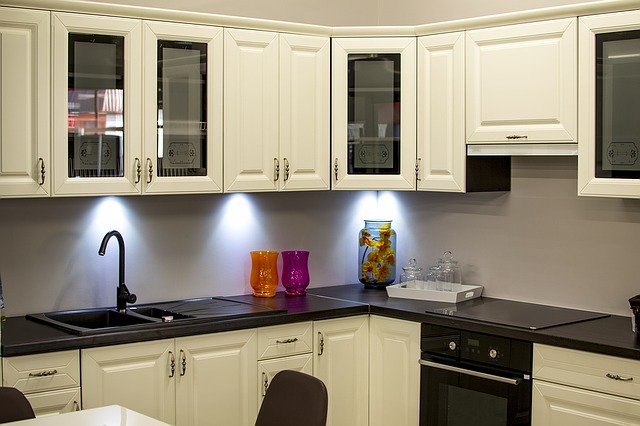Fitted kitchen

|
Contents |
[edit] Introduction
A fitted kitchen is a kitchen layout (usually domestic) [1] that typically involves a streamlined arrangement of cupboards under a continuous worktop complemented by wall cabinets (matching). The worktop usually has a built-in sink and may feature a built-in gas or electric hob, while spaces below the worktop may include integrated ovens, washing machines and dishwashers. They are sometimes referred to as ‘built-in’ kitchens. Their appearance is typically one of modular neatness and co-ordination.
Worktops are usually arranged according to the space available: a long narrow kitchen may have a ‘galley’ [2] layout with units and worktops arranged linearly on either one or both sides. If there is more space, the worktop can take the form of a peninsula – accessible on three sides. Larger kitchens can usually accommodate various arrangements of worktops such as an ‘island’ – a free-standing worktop with units below or a breakfast bar.
[edit] A brief history
Before fitted kitchen, arrangements would typically consist of freestanding elements – cupboards, range cookers and ovens, dressers, sinks, refrigerators and other items. This tended to be both uncoordinated, untidy and inefficient. It could also be unhygienic, as cleaning between the freestanding items could be difficult due to space restrictions.
The continuous worktop surface and under-counter appliances offered easy maintenance and is a manifestation of the drive toward labour-saving devices which dominated much of the 20th century and continues today.
Fitted kitchens were pioneered in the US and were not generally adopted in the UK until well after the Second World War, although built-in cupboards had started to make an appearance in the 1930s. The trend for more easily-maintained houses was driven in part by the demise of domestic servants.
[edit] Design and installation
The basis of the fitted kitchen is modularity – a module of 600mm x 600mm is typically used for planning and installation. Under-worktop units (or carcasses) can come in these and other dimensions including widths of 300mm, 400mm, 500mm and 600mm. These extra widths are useful in accommodating dimensions that are not a factor of six. For example, a length of 2.7m can be fitted with two 600mm units, one 1200mm unit, and one of 300mm.
Carcasses, or cabinets (the name given to the cupboards) are supplied either in flat-pack kits (assembled on site) or less commonly as pre-assembled units. Apart from the worktop itself, the cabinet doors usually provide the main colour of the kitchen and are available in a wide range of styles and finishes.
Accessories that can complement a fitted kitchen include lighting for worktops, skirting boards, extractor hoods and pull-out storage and so on.
Fitted kitchens can be supplied (and sometimes installed) by the major D-I-Y chain stores or by independent kitchen suppliers who tend to offer kitchens at the upper end of the market. Installation can be undertaken either by the supplier or by an independent kitchen installer. The benefits of the former method are that any problems or complaints can be addressed back to a single party.
[edit] Notes
1 Fitted kitchens are also seen in canteens and other commercial and industrial food preparation areas.
2 The term derives from the narrow kitchens often found in ships’ galleys, which also incorporated continuous work surfaces.
[edit] Related articles on Designing Buildings Wiki
Featured articles and news
Infrastructure that connect the physical and digital domains.
Harnessing robotics and AI in challenging environments
The key to nuclear decommissioning and fusion engineering.
BSRIA announces Lisa Ashworth as new CEO
Tasked with furthering BSRIA’s impressive growth ambitions.
Public buildings get half a million energy efficiency boost
£557 million to switch to cleaner heating and save on energy.
CIOB launches pre-election manifesto
Outlining potential future policies for the next government.
Grenfell Tower Inquiry announcement
Phase 2 hearings come to a close and the final report due in September.
Progress from Parts L, F and O: A whitepaper, one year on.
A replicated study to understand the opinion of practitioners.
ECA announces new president 2024
Electrical engineer and business leader Stuart Smith.
A distinct type of countryside that should be celebrated.
Should Part O be extended to existing buildings?
EAC brands heatwave adaptation a missed opportunity.
Definition of Statutory in workplace and facilities management
Established by IWFM, BESA, CIBSE and BSRIA.
Tackling the transition from traditional heating systems
59% lack the necessary information and confidence to switch.
The general election and the construction industry
As PM, Rishi Sunak announces July 4 date for an election.
Eco apprenticeships continue help grow green workforce
A year after being recognised at the King's coronation.
Permitted development rights for agricultural buildings
The changes coming into effect as of May 21, 2024.





















